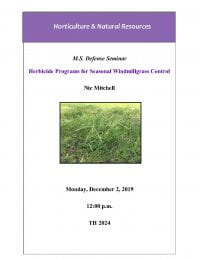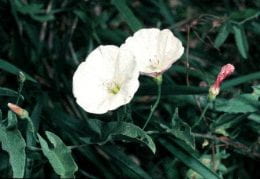By Daniele McFadden (recent M.S. graduate at K-State)
With spring in full swing many of you are taking advantage of the warm soil temperatures and overseeding turf areas. Often times we can mistakenly coincide our spring-time herbicide applications with seeding cool-season turf. So, are your new seedlings going to mature and develop if this happens? Research was done over the last two years to evaluate how several herbicides affect the emergence and growth of tall fescue and Kentucky bluegrass when seeded after application. Following are some takeaways from these experiments.
The good:
- When dandelions and other common broadleaves start to appear, a standard three-way postemergence broadleaf product containing 2,4-D + MCPP + dicamba (numerous trade names) is often applied. In both the field and greenhouse, we found that seeding tall fescue into an area treated with this herbicide combination was safe on the seedlings, and was comparable to tall fescue growth in areas where the herbicide wasn’t applied.
- Other combination products used for control of broadleaf weeds were found safe on tall fescue seedlings when seeding was done 0 to 14 days after herbicide application. These herbicides included:
- Carfentrazone-ethyl + MCPP + 2,4-D + dicamba (SpeedZone)
- Fluroxypyr + halauxifen-methyl + 2,4-D (GameOn)
- Triclopyr + pyraflufen-ethyl + 2,4-D + dicamba (4-Speed XT)
The bad:
- Playing catch-up with yellow nutsedge control? Applying halosulfuron-methyl (Sedgehammer and other trade names) in late summer or early fall for the control of nutsedge could affect your tall fescue and Kentucky bluegrass seedlings if seeding occurs within two weeks of application. Both cool-season grasses emerged in the field with mild chlorotic symptoms that went away within 8 weeks after seeding. However, a closer look at root development showed that seeding tall fescue into soil treated with halosulfuron-methyl significantly stunted development. The Sedgehammer label guidelines clearly state that a four-week delay after application is needed. Plan your nutsedge control earlier in the summer so it does not interfere with early fall seeding.
The ugly:
- Did you accidentally apply a preemergence herbicide for crabgrass control before seeding? You might be wasting your seed. Our studies found that seeding tall fescue or Kentucky bluegrass into an area treated with dithiopyr (Dimension) greatly inhibited growth of the seedlings.
Bottom line – reading the label to learn how soon seeding can be done after herbicide application is critical. Labels on some of these products indicate that seeding should be done after a longer interval has passed after application compared to what was observed as required in this research. Seeding guidelines on labels must be followed; that said, research results from this project provide useful information to herbicide manufacturers and turf managers who may unknowingly seed into herbicide-treated areas.

These research results will soon appear in greater detail in K-State’s 2021 Turfgrass Research Research Report.
***Mention of trade names or commercial products in this article is solely for identification purposes and does not imply recommendation or endorsement, nor is criticism implied of similar products not mentioned by Kansas State University.***
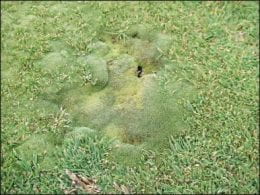

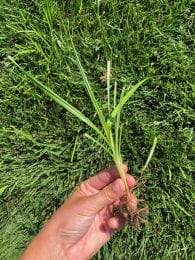

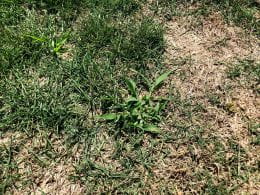

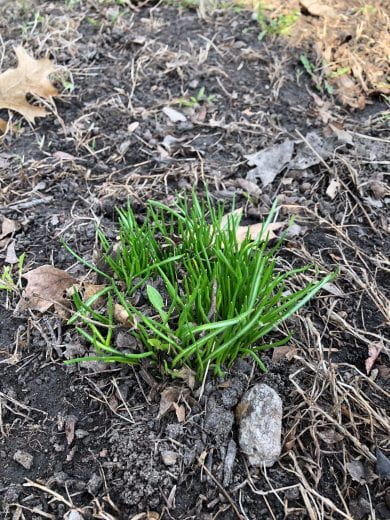

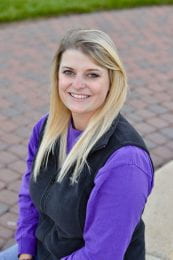 Meet Dani McFadden!
Meet Dani McFadden!  Meet Nic Mitchell!
Meet Nic Mitchell!  “Windmillgrass (Chloris verticillata Nutt.) is a problematic perennial grassy weed commonly found in the mid-west. Currently, there are the only two labeled chemical control options in turfgrass. Tenacity (mesotrione) is labeled for two applications for control while Pylex (topramezone) is labeled for a single application for control. We conducted research to determine if a single application of a common selective perennial grass herbicides would completely control windmillgrass, and to their efficacy when applied at spring, summer, and fall application timings. The next research study that we conducted was to explore the addition of triclopyr to mesotrione, topramezone, and fenoxaprop as well as triclopyr alone. Sequential applications of these herbicides and herbicide combinations were also applied. The last research trial we conducted was to determine the effects of windmillgrass response to glyphosate at different rates with fall applications similar to common recommended perennial weed control options.”
“Windmillgrass (Chloris verticillata Nutt.) is a problematic perennial grassy weed commonly found in the mid-west. Currently, there are the only two labeled chemical control options in turfgrass. Tenacity (mesotrione) is labeled for two applications for control while Pylex (topramezone) is labeled for a single application for control. We conducted research to determine if a single application of a common selective perennial grass herbicides would completely control windmillgrass, and to their efficacy when applied at spring, summer, and fall application timings. The next research study that we conducted was to explore the addition of triclopyr to mesotrione, topramezone, and fenoxaprop as well as triclopyr alone. Sequential applications of these herbicides and herbicide combinations were also applied. The last research trial we conducted was to determine the effects of windmillgrass response to glyphosate at different rates with fall applications similar to common recommended perennial weed control options.”